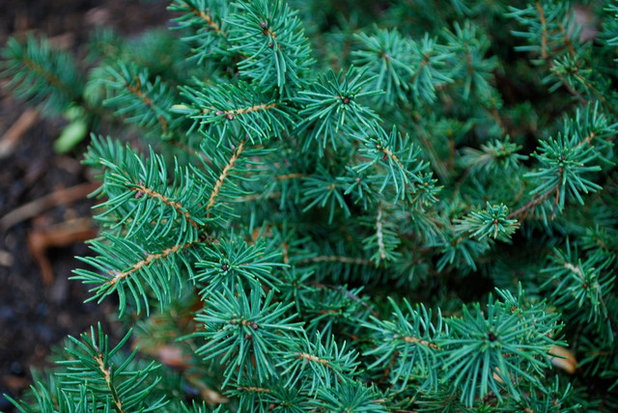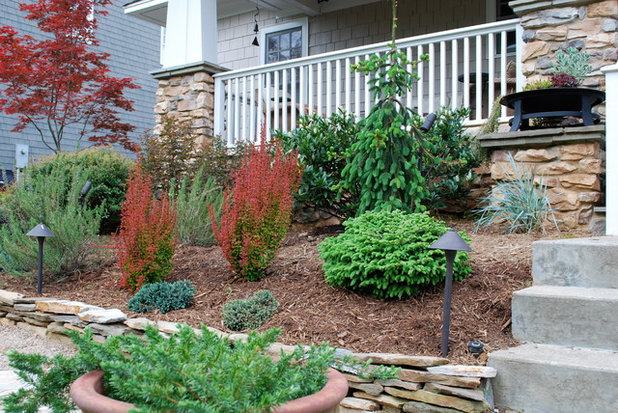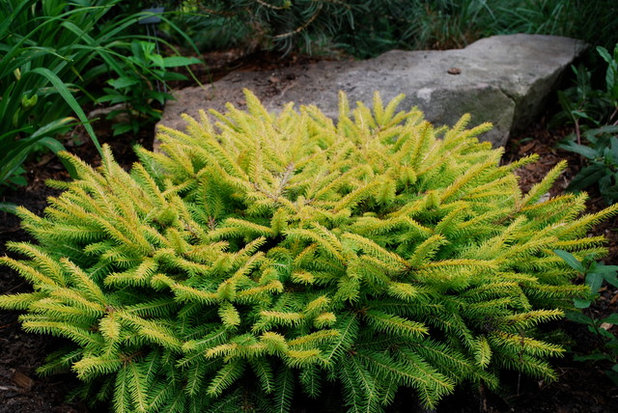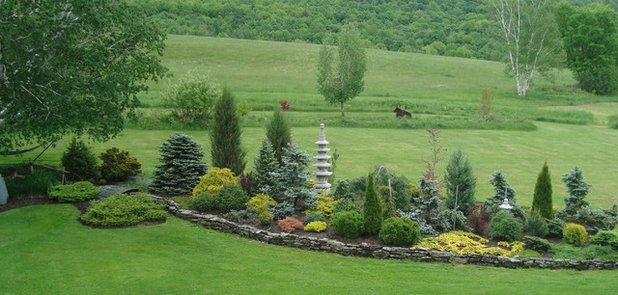The winter garden can be a lonely place, as the frills and thrills of summer annuals and flowering perennials have disappeared from the solemn landscape. It’s at this time of year when garden structure, along with plant texture and shape, become more vital than ever, providing the beauty and solace that tide us over until spring ephemerals jump to life. Bird’s nest spruce (
Picea abies ‘Nidiformis’) proves its worth as a winter garden workhorse.

Jay Sifford Garden Design

Jay Sifford Garden Design
Botanical name: Picea abies ‘Nidiformis’
Common name: Bird’s nest spruce
Origin: The species is native to Northern Europe, but Nidiformis is a garden variety.
Where will it grow: Hardy to -50 degrees Fahrenheit (USDA zones 2 to 8; find your zone)
Light requirement: Full sun to partial shade
Water requirement: Average (1 inch of water per week until well established)
Mature size: Slow growing to 2 feet tall and 8 feet wide
Benefits and tolerances: Resists deer, rabbits, insects and disease; drought resistant once established
Seasonal interest: New growth appears in midspring as light green tips, providing beautiful contrast to the dark green mature foliage; Nidiformis earns its place in the winter garden when its low, round form contrasts with the winter landscape.
When to plant: Spring or fall is preferable.

Jay Sifford Garden Design
Distinguishing traits. Bird’s nest spruce is low to the ground and round, unlike the popular weeping Norway spruce (
Picea abies ‘Pendula’). Both are shown here.
Note: Whereas the type species is considered invasive in some areas of the U.S. because its growth habit inhibits light and subsequent growth of native species at the forest floor, ‘Nidiformis’ is low growing and considered sterile.

Jay Sifford Garden Design
Bird’s nest spruce is sometimes confused with Globosa blue spruce (
Picea pungens ‘Globosa’, zones 2 to 8). There are, however, several colorful variations of
Picea abies ‘Nidiformis’ available in the trade. Shown here is the beautiful chartreuse cultivar ‘Vermont Gold’. Its new growth is both bright and stunning.
For smaller spaces a dwarf offering known as ‘Little Gem’ is commonly available and recommended. Smaller yet is ‘Pusch’, which grows to 1 foot tall and 2 feet wide. Pusch is unique in that it sports many bright pinkish-red cones in late spring.

Garden Arts / Manchester Fence Company
How to use it. Bird’s nest spruce provides year-round structure in a variety of spaces, from mixed beds to conifer gardens. It is best used in the front of the border or in open areas of the garden surrounded by larger, very structural shrubs and trees. Additionally, this conifer provides contrast when used alongside vertical perennials, such as iris. I enjoy using it in close proximity to boulders, as its shape mimics that of the boulder. It can be used as a foundation planting. Its low, semiformal shape makes it a good choice for flanking porch steps.
Planting notes. Bird’s nest spruce is best planted in average, well-drained soil, as it does not tolerate wet, soggy soil. Consider planting it in a location that receives a minimum of a half a day of sun. Water consistently (1 inch of water per week) until it is well established.
More: What to Do in Your Garden This Month
Stretch the Budget, Seasons and Style: Add Conifers to Your Containers





